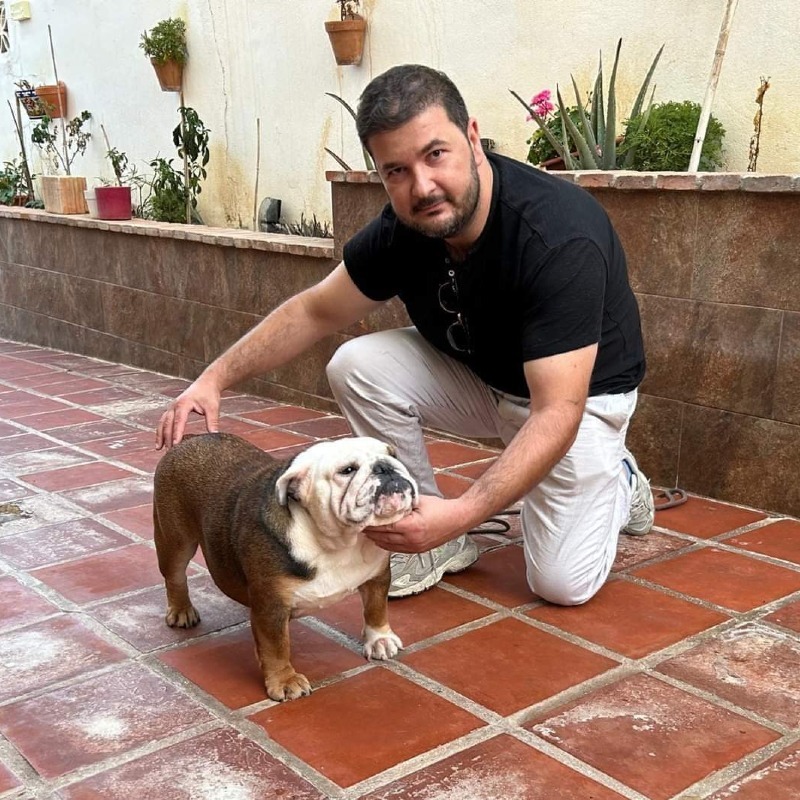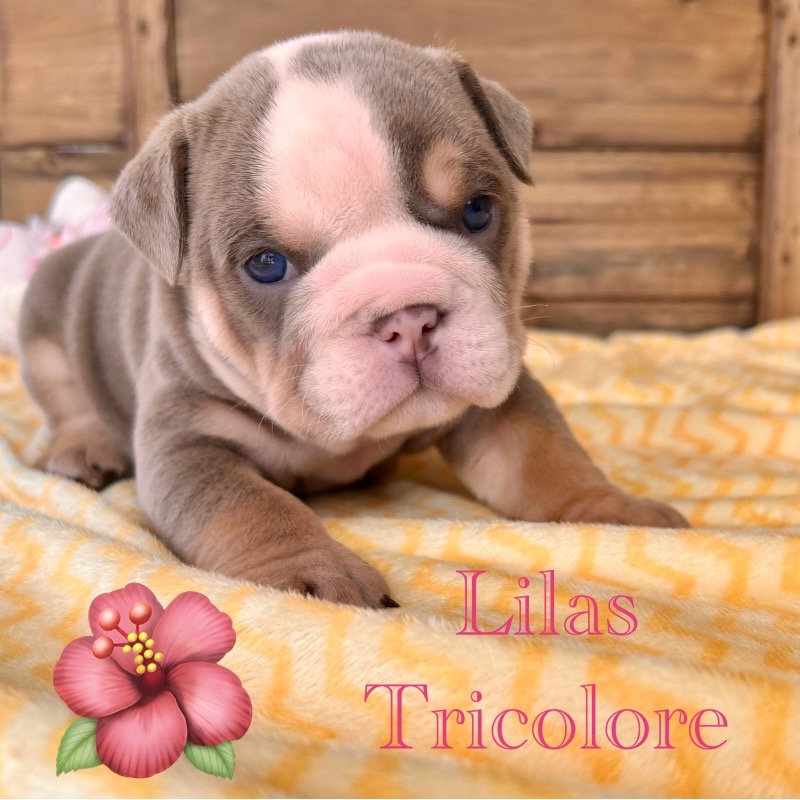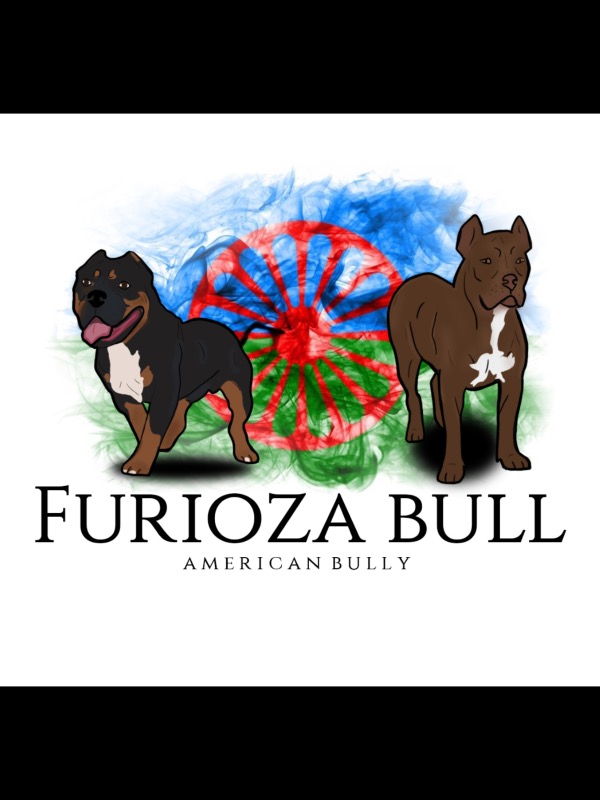English bulldog
Autres noms : English bull, British bulldog
Discover the English Bulldog, a loving companion with a sweet and spirited nature. Learn more about its distinctive traits, friendly behavior, and care needs.
Awareness of acquiring an animal
Adopting or breeding a dog is a responsibility that must be carefully considered. Dogs are loyal companions that require time, attention, and constant care. Whether for leisure, passion, or professional breeding, it is crucial to understand the specific needs of each breed. Provide them with a loving and stimulating environment, and avoid any impulsive acquisition that could harm their well-being. Be a vigilant and committed owner for a happy and healthy companion.
To learn more about animal welfare, we invite you to consult our FAQ by clicking the button below:
Origins and history
The English bulldog traces its origins back to medieval fighting dogs, particularly in England. These animals were initially used in arenas to bait and capture bulls, a practice known as "bull-baiting." Over the centuries, the brutality of these fights drew controversy, leading to the ban of this practice in 1835. This marked the beginning of a significant evolution for the breed.
With the prohibition of bull-baiting, breeders began to select animals with gentler temperaments and less aggressive physical characteristics. By the 19th century, the popularity of the bulldog transformed, and it became a beloved companion in British households. Physically, it was shaped to have a flat face, a muscular yet compact body, and a distinctive gait. These traits make it easily recognizable and appreciated today.
The English bulldog has become emblematic due to its affectionate nature and loyalty. At the same time, it is often seen as a symbol of British culture. The breed continues to evolve, but its ancient roots remain evident, reminding us of its unique journey and adaptation over the centuries.
Physical characteristics
The English Bulldog is distinguished by its stocky and compact silhouette. Its massive head is round, with a broad skull and prominent cheeks, creating a characteristic face. The skin folds, particularly on the forehead and around the nose, contribute to its unique personality. This dog has a short and flat nose, sometimes referred to as "brachycephalic," giving it a distinctive appearance.
The eyes of the Bulldog are generally dark, round, and wide, with a gentle yet wary expression. Its ears, small to medium in size, are often inactive, preferring to fold forward, which adds to its charm. The neck is short and thick, supporting a wide and deep chest.
As for its morphology, the English Bulldog is rather low to the ground, with sturdy and well-muscled limbs. The tail is short and can be either curled or straight. Its coat is generally short and smooth, coming in a variety of colors, including brindle, fawn, or white. These physical characteristics give this breed an appearance that is both emblematic and endearing.
Character
The English Bulldog is a dog with a distinctive personality. Known for its affable nature, it is very attached to its owners and often shows affection. This breed is sociable, loves spending time with humans, and is generally kind towards children, making it an ideal companion for families. Its calm and quiet nature also makes it suitable for apartment living, as it requires less physical exercise than other breeds.
The intelligence of the English Bulldog is notable, but it often manifests as a certain independence. It can be stubborn, which can make training a bit more complex. A positive and patient approach to training is essential for this animal to cooperate. Despite its robustness, this breed is sensitive and responds better to encouragement rather than harsh training methods.
In summary, the English Bulldog possesses a unique blend of gentleness and character, along with great loyalty to its family. Adaptable to different lifestyles, it provides a reassuring presence, making it highly sought after as a pet.
Life expectancy
The lifespan of an English bulldog typically ranges from 8 to 10 years. This duration can vary based on several factors, including genetics, diet, physical exercise, and veterinary care. English bulldogs have certain genetic predispositions to health issues, which can influence their longevity.
These dogs are prone to conditions such as respiratory diseases due to their unique morphology, as well as joint problems related to their heavy build. Therefore, it is essential to follow a suitable care and health program, including regular veterinary visits and vaccination monitoring.
A proper diet also plays a crucial role in preventing certain diseases and maintaining an ideal weight, which can contribute to a longer and healthier life. Moreover, an appropriate level of physical activity tailored to their condition is vital to ensure their overall well-being. With proper care, some English bulldogs can live beyond 10 years, highlighting the importance of their owners' commitment to their health.
Exercise and activity needs
The English bulldog is a dog with a calm and composed temperament, but its exercise and activity needs must be taken into account to ensure its well-being. Generally, this breed requires moderate activity. A daily walk of 30 minutes is often sufficient to meet its physical needs. However, these dogs should not be subjected to excessive effort, as their physical build makes them sensitive to heat and intense exercise.
Interactive games and play sessions in a safe environment are other ways to encourage physical activity. Games such as fetch or tug toys can stimulate their agility while strengthening the bond with their owner. It is important to monitor signs of fatigue, as these dogs can sometimes be reluctant to slow down.
In terms of exercise, socialization is also crucial. Walks in parks or areas where they can meet other dogs promote their social development. In summary, a mix of moderate exercise and playful activities helps keep the English bulldog healthy while respecting its physical limits.
Recommended diet
The English Bulldog has specific dietary needs due to its morphology and predispositions to certain health conditions. A balanced diet is essential for maintaining its health and well-being. Owners should prioritize high-quality kibble that is rich in animal proteins to promote muscle development without excessive weight gain. A high protein content, but moderately reduced in fats, is ideal.
Bulldogs tend to suffer from obesity, which is why it's important to control portion sizes and maintain regular meal times. It is recommended to divide their daily ration into two meals to avoid digestive problems. Additionally, it is advisable to choose foods that contain complex carbohydrates, such as brown rice or sweet potatoes, which provide energy without causing a rapid spike in blood sugar levels.
Finally, hydration is crucial. Be sure your pet always has access to fresh water. Dietary supplements, such as omega-3s and vitamins, can also be beneficial for its skin and coat. A veterinary consultation can help tailor the diet according to your bulldog's specific needs.
Training and obedience
The English Bulldog is a dog breed known for its gentle and sociable nature, but its training requires a patient and consistent approach. From a young age, it is important to introduce the puppy to socialization. Exposing the dog to different environments, people, and other animals will help reduce anxiety and develop a balanced personality. Early interactions are crucial for teaching them to interact positively with their surroundings.
In terms of training, positive reinforcement is recommended. This type of education relies on rewards rather than punishment. Using treats, praise, or playtime to encourage desired behaviors helps strengthen the bond between the owner and the dog. Patience is essential, as this breed can sometimes be stubborn. Training sessions should be short and fun to keep the dog's interest.
Finally, it is crucial to take into account the physical characteristics of the breed, particularly their brachycephalic appearance. This means ensuring that they do not overexert themselves during physical activity, especially in hot weather. A good balance of play, training, and rest is the key to a happy and well-trained English Bulldog.
Behavior with children
The English bulldog is renowned for its affectionate temperament and gentle nature, making it an ideal companion for children. This breed is distinguished by its patience and tolerance, traits that allow it to coexist peacefully with youngsters. Bulldogs are generally friendly and enjoy interacting with family members, often forming strong and lasting bonds with children.
However, it is important to supervise interactions between the dog and young children. Although most bulldogs are very gentle, their size and strength can sometimes be intimidating to smaller ones. Therefore, it is essential to teach children how to approach and treat the animal with respect. Educating them about the signs of stress or discomfort in the dog will help create a climate of trust.
Additionally, this breed does not require a lot of exercise, which makes it suitable for a more laid-back family life. Age-appropriate play sessions can encourage a wonderful bond. With their playful character, bulldogs often make good playmates, bringing joy and entertainment to the household. They can also help children develop skills related to responsibility and empathy towards animals.
Compatibility with Other Animals
The English Bulldog is a dog renowned for its amiable temperament and sociable nature. This makes it an excellent companion in a household where other pets coexist. Their calm and laid-back character generally allows them to get along with other dogs, as well as with smaller animals, such as cats. However, the introduction of different members of the animal family must be done with caution, especially if the English Bulldog has not yet been socialized.
It is essential to take into account the size and energy of the other animals during their coexistence. English Bulldogs tend to be quite relaxed and may not adapt as well to very active or playful companions. Supervised interactions are recommended, especially during initial meetings, to ensure that all animals feel safe and comfortable.
Finally, each individual's distinctive character can also influence the dynamics of coexistence. Some Bulldogs may have a more pronounced protective instinct, which could lead to dominant behaviors. Early socialization and appropriate training sessions are therefore crucial to ensure harmony within the household. In summary, with a patient and thoughtful introduction, the English Bulldog can harmoniously integrate into an environment where other animals reside.
Grooming needs
The English Bulldog requires regular grooming to maintain its health and well-being. Due to its short coat, weekly brushing is usually sufficient to remove dead hairs and reduce the risk of dandruff. This brushing also helps stimulate blood circulation in the skin.
The characteristic skin folds of this breed need special attention. It is essential to clean them regularly with a soft, damp cloth to prevent infections. Residue, moisture, or dirt accumulated in these folds can lead to irritations or dermatological issues.
Regarding dental care, it is recommended to brush the dog's teeth several times a week to prevent tartar buildup and oral diseases. Finally, the nails should be trimmed regularly to avoid pain and injuries, especially if the dog does not naturally wear down its nails due to a mainly indoor lifestyle. In summary, regular maintenance will ensure the health and happiness of this affectionate breed.
Health
The health of the English Bulldog is a crucial topic due to its predisposition to several health issues. Due to their morphology, these dogs can suffer from hip dysplasia and joint problems. It is essential to maintain a healthy weight, as obesity can exacerbate these conditions and lead to other complications.
Another aspect to consider is respiratory health. The structure of their flat head can cause breathing difficulties, particularly brachycephalic syndrome. Owners should pay attention to their pet's breathing, especially in hot weather or during physical exertion.
It is also important to monitor the skin, as these dogs can be prone to skin infections, particularly in the folds of their skin. Regular grooming and appropriate bathing are necessary to prevent these problems.
Finally, regular veterinary visits and a proper diet will help ensure a long and healthy life for the English Bulldog. Proactive prevention is key for this delicate breed.
Environment and habitat
The English Bulldog is a dog breed that requires a suitable environment to ensure its well-being. This dog is primarily suited for indoor living, making it an excellent companion for families living in apartments or houses. Its calm temperament and compact size allow it to easily adapt to small spaces, as long as its daily exercise needs are met.
Regarding climatic conditions, the breed is sensitive to extreme temperatures. Due to its short nose, the bulldog has difficulty regulating its body temperature, making hot days particularly challenging for it. Therefore, it is essential to ensure that it has access to a cool and shaded area during the summer. Likewise, during the colder months, a comfortable and warm shelter is necessary to ensure its health.
As for its habitat, early socialization is recommended. Interaction with other animals and people from a young age helps develop a well-balanced adult. Regular, albeit moderate, walks are also needed to maintain its physical fitness and stabilize its behavior. Finally, it is important to provide a dedicated space for it to rest, as it enjoys spending time sleeping and relaxing, further reinforcing its role as a calming life companion.
Name ideas
Choosing a name for an English bulldog is an important step that can reflect the personality of your future companion. Start by observing the physical and behavioral characteristics of your dog. English bulldogs, with their sturdy appearance and gentle temperament, inspire names that evoke both their strength and tenderness.
Also, think of names that have a pleasant sound and are easy to pronounce. Dogs respond better to short and impactful names. Avoid names that are too complicated or resemble commands you might use.
Draw inspiration from pop culture, history, or specific traits of the bulldog. Ultimately, the choice of a name should be personal and reflect the bond you share with your pet.
Here are about fifteen suggestions: Winston, Brutus, Pippa, Daisy, Choco, Hugo, Bella, Zeus, Olive, Rocky, Lola, Goliath, Trixie, Max, and Ruby. These names evoke both the sturdiness and the sweetness of the breed while being easy to remember.
Average purchase price
The price of an English bulldog can vary significantly depending on several factors. Generally, the average cost of a puppy can range from 1,000 to 4,000 euros. Several elements influence this price range.
First of all, the reputation of the breeder is a crucial aspect. Responsible breeders, who prioritize the health and well-being of the animals, may charge higher prices. These breeders often conduct health tests on the parents, which ensures that the puppies are less likely to develop hereditary issues. In contrast, puppies from less reputable sources may be cheaper but are also more likely to have health problems.
Next, the lineage of the puppy plays an important role in the cost. A puppy coming from champion bloodlines or with good pedigree may have a higher price due to its genetic qualifications. Other factors, such as coat color or markings, can also influence the price, with certain shades being more sought after than others in the market.
Finally, additional costs, such as vaccinations, spaying or neutering, and initial veterinary care, should also be considered in the overall budget for acquiring an English bulldog.
Expenses
Owning an English Bulldog entails significant monthly expenses, starting with food costs. On average, a dog of this breed requires high-quality food, which can cost between 50 and 100 euros per month, depending on the type of kibble chosen.
Regular veterinary care also represents a substantial part of the budget. Annual visits for vaccinations and health check-ups can amount to approximately 80 euros per month when the costs are spread throughout the year. Additionally, it's advisable to set aside a small budget for unexpected health issues that may arise.
Hygiene expenses, such as grooming and dental care, should also be taken into account. Expect to pay about 30 to 50 euros per month for these services, depending on the need for regular grooming. Don’t forget essential supplies: toys, bedding, and accessories, which can add another 20 to 40 euros per month.
Finally, activities such as socialization, training, or walks with a professional are other expenses you will need to consider. In summary, the overall monthly budget for an English Bulldog can vary between 200 and 300 euros, depending on individual choices and needs.
Destination and usage
The English Bulldog is a highly regarded dog breed as a pet due to its unique personality and distinctive appearance. These dogs are known for their calm and affectionate temperament, making them excellent companions for families. Their friendly disposition allows for good interaction with children, bringing a warm and joyful atmosphere to the home. They also enjoy the company of adults and can form strong bonds with all family members.
Regarding their suitability as pets, this breed is particularly well-suited for apartment living. Their compact size and moderate energy level mean they do not require a very large space to thrive. A good number of daily walks and playtime are sufficient for their well-being. Additionally, their gentle nature makes them compatible with other pets, promoting a harmonious environment at home.
English Bulldogs are also known for their protective nature, although they are generally not aggressive. They can act as watchdogs in a sense, being alert to noises and visitors. Their reassuring presence and loyalty make them faithful companions who adapt well to various lifestyles, bringing comfort and joy to their owners.
Legislation and regulation
The legislation regarding English bulldog breeds varies significantly from country to country due to concerns related to health and animal welfare. In some countries, specific laws govern the ownership of this breed, which is often seen as having health issues due to its morphology. For example, regulations impose strict criteria regarding the breeding and sale of dogs in order to minimize the risks of hereditary diseases.
In Europe, several countries have adopted standards to ensure that dogs are bred in conditions that promote their health. Veterinary authorities monitor breeding and can prohibit the reproduction of dogs with genetic health problems. In contrast, in other areas, such as some states in the United States, there are no specific regulations, leading to debates over animal protection and the ethics of breeding.
Animal protection movements advocate for a total ban on breeding this breed in countries where its popularity is high, arguing that the suffering caused by health problems does not justify the continuation of the breed. In summary, the legislation surrounding this breed reflects a complex balance between the popularity of pets and the increasing need to protect the health and well-being of animals.
Official recognition
The official recognition of the English Bulldog breed varies by country, with each nation having its own standards and cynological organizations. In most European countries, this breed is recognized by the Fédération Cynologique Internationale (FCI), which sets precise standards regarding its physical and behavioral characteristics. This recognition ensures a rigorous monitoring of breeding practices and aims to improve the breed's health.
In North America, particularly in the United States and Canada, the breed is also accepted by major local cynological organizations. These organizations implement health and prevention programs aimed at reducing common issues associated with the breed, notably those related to breathing and skin.
Other countries, especially in Asia and Africa, are beginning to adopt official recognition of the breed, although the regulatory framework is often less structured. Local clubs and breeders are mobilizing to raise public awareness about the importance of responsible breeding to preserve the health and integrity of this breed.
In summary, official recognition establishes an essential framework to protect the well-being of English Bulldogs while supporting a community of dedicated breeders.
Pedigrees
For breeders and owners of English Bulldogs who wish to obtain a pedigree, several registries and clubs are essential. The main registry is the **Kennel Club**, which is the British canine authority responsible for managing pedigrees for various breeds, including the English Bulldog. Dogs registered with the Kennel Club benefit from a recognized pedigree that certifies their lineage and compliance with breed standards.
In France, the **Société Centrale Canine** is equivalent to the Kennel Club. It is responsible for managing birth certificates and pedigrees for purebred dogs in France. Breeders must register their puppies with the SCC to obtain an official pedigree. This document is crucial for participating in dog shows and competitions.
Additionally, breed clubs such as the **Club du Bouledogue Anglais** in France provide resources, information, and support for those breeding or owning this breed. These clubs can also organize events and competitions, strengthening the bond between breeders and owners while promoting the welfare and standards of the breed. By joining these clubs, owners can receive guidance on responsible breeding practices.
Prohibitions
Dog breed bans can vary significantly from country to country. In some countries, strict laws prohibit the ownership of breeds deemed dangerous or aggressive, leading to consequences for owners of certain popular breeds. Although the English Bulldog is not typically classified among these breeds, concerns about the health and well-being of the animals may lead to specific regulations.
In Europe, several nations have implemented legal requirements to ensure the safety of citizens. In some states, special permits may be required to own certain breeds, and regulations may include mandatory sterilization or identification of animals. The well-being of dogs is also at stake, as animal protection organizations advocate for amendments regarding breeds at high risk for health problems.
Additionally, in urban areas, restrictions may exist regarding living space and suitable living conditions. Regulations often aim to ensure that owners can provide an appropriate environment for their pets, avoiding potential nuisances or behavioral issues. Finally, the growing awareness surrounding animal health and behavior means that some countries might consider future bans, thereby emphasizing animal welfare.
Breeders of English bulldog
Want to see more breeders of English bulldog?
Check out the page of our directory listing all breeders of English bulldogClassified Ads of English bulldog
Breed clubs of english bulldog
No of english bulldog breed clubs are currently registered on Preeders.
If you would like to highlight your breed club, sign up for free now and be the first to appear on this page.












